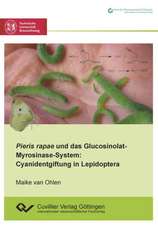Nuclear-Cytoplasmic Transport: Nucleic Acids and Molecular Biology, cartea 33
Editat de Weidong Yangen Limba Engleză Hardback – 11 aug 2018
| Toate formatele și edițiile | Preț | Express |
|---|---|---|
| Paperback (1) | 998.34 lei 6-8 săpt. | |
| Springer International Publishing – 2 feb 2019 | 998.34 lei 6-8 săpt. | |
| Hardback (1) | 1004.36 lei 6-8 săpt. | |
| Springer International Publishing – 11 aug 2018 | 1004.36 lei 6-8 săpt. |
Din seria Nucleic Acids and Molecular Biology
- 18%
 Preț: 1111.53 lei
Preț: 1111.53 lei - 18%
 Preț: 1003.38 lei
Preț: 1003.38 lei - 15%
 Preț: 639.41 lei
Preț: 639.41 lei - 15%
 Preț: 647.08 lei
Preț: 647.08 lei - 15%
 Preț: 642.68 lei
Preț: 642.68 lei - 15%
 Preț: 642.36 lei
Preț: 642.36 lei - 18%
 Preț: 1822.76 lei
Preț: 1822.76 lei - 18%
 Preț: 1231.32 lei
Preț: 1231.32 lei - 20%
 Preț: 990.62 lei
Preț: 990.62 lei - 18%
 Preț: 956.99 lei
Preț: 956.99 lei - 15%
 Preț: 637.28 lei
Preț: 637.28 lei - 5%
 Preț: 1102.31 lei
Preț: 1102.31 lei - 18%
 Preț: 1218.17 lei
Preț: 1218.17 lei - 18%
 Preț: 947.98 lei
Preț: 947.98 lei - 18%
 Preț: 1384.26 lei
Preț: 1384.26 lei - 18%
 Preț: 1227.52 lei
Preț: 1227.52 lei - 18%
 Preț: 1228.29 lei
Preț: 1228.29 lei - 18%
 Preț: 1225.79 lei
Preț: 1225.79 lei - 18%
 Preț: 942.13 lei
Preț: 942.13 lei - 18%
 Preț: 1222.62 lei
Preț: 1222.62 lei - 18%
 Preț: 950.03 lei
Preț: 950.03 lei - 18%
 Preț: 1216.02 lei
Preț: 1216.02 lei - 18%
 Preț: 953.20 lei
Preț: 953.20 lei - 18%
 Preț: 949.73 lei
Preț: 949.73 lei - 15%
 Preț: 646.30 lei
Preț: 646.30 lei - 18%
 Preț: 895.27 lei
Preț: 895.27 lei - 18%
 Preț: 894.34 lei
Preț: 894.34 lei
Preț: 1004.36 lei
Preț vechi: 1224.83 lei
-18% Nou
Puncte Express: 1507
Preț estimativ în valută:
192.18€ • 200.67$ • 158.70£
192.18€ • 200.67$ • 158.70£
Carte tipărită la comandă
Livrare economică 15-29 aprilie
Preluare comenzi: 021 569.72.76
Specificații
ISBN-13: 9783319773087
ISBN-10: 3319773089
Pagini: 350
Ilustrații: VI, 274 p. 44 illus., 40 illus. in color.
Dimensiuni: 155 x 235 mm
Greutate: 0.57 kg
Ediția:1st ed. 2018
Editura: Springer International Publishing
Colecția Springer
Seria Nucleic Acids and Molecular Biology
Locul publicării:Cham, Switzerland
ISBN-10: 3319773089
Pagini: 350
Ilustrații: VI, 274 p. 44 illus., 40 illus. in color.
Dimensiuni: 155 x 235 mm
Greutate: 0.57 kg
Ediția:1st ed. 2018
Editura: Springer International Publishing
Colecția Springer
Seria Nucleic Acids and Molecular Biology
Locul publicării:Cham, Switzerland
Cuprins
Assembly of the nuclear pore complex.- Structure of Yeast nuclear pore complexes.- Structure and function of nucleoporins in nuclear transport.- Dynamic structures of the nuclear pore complex and their roles in nucleo-cytoplasmic transport.- Non-canonical roles of nuclear pore proteins.- On the role of the channel nucleoporins in nuclear transport.- Structures of Importins and Exportins.- Navigating the Nuclear Envelope: one or multiple transport mechanisms for integral membrane proteins?.- mRNA export and its dysregulation in disease.- Coarse-grained molecular dynamics of the natively-unfolded domain of the NPC.- On the effects of leukemogenic nucleoporin fusion proteins on nucleocytoplasmic transport and gene expression.- Structure and Function of the Nuclear Pore Complex Revealed by Advanced Fluorescence Microscopy.
Notă biografică
Weidong Yang, Ph.D. Dr. Yang is interested in exploring the molecular transport mechanisms in cells by using single-molecule tracking, super-resolution microscopy imaging and nanotechnology. His research laboratory is highly motivated to develop innovative research tools to meet the needs of solving challenging biological and biomedical problems, as they have done in the past and will be doing in the future. Currently, by developing and employing high-speed super-resolution microscopy techniques, Dr. Yang and his research team aim to solve two critical transport mechanisms involving three sub-cellular organelles in eukaryotic cells: nucleus, cytoplasm and primary cilium. Macromolecular trafficking among these compartments is suggested to be gated by two unique machineries. One is the nuclear pore complex (NPC) embedded in the nuclear envelope that mediates the bidirectional trafficking of proteins and RNAs between the cytoplasm and the nucleus; the other is the transition zone (TZ) located at the base of cilium that regulates the entry of membrane and cytosolic proteins into the cilium. Due to the challenges in elucidating kinetics and real-time transport routes for macromolecules through the sub-micrometer NPC or TZ in live cells, however, the fundamental gating mechanisms in either of these two machineries, remain obscure. Moreover, these transport mechanisms are not only the fundamental unanswered questions in cell biology, but also are closely associated with human diseases. For example, dysfunction of the nuclear transport through the NPC are linked to numerous human diseases including leukemias, cancers, and primary biliary cirrhosis. Also, defects in ciliary structure and/or function causes a variety of diseases (called ciliopathies) such as cystic kidney disease, nephronophthisis (NPHP), and retinitis pigmentosa. Thus, the fundamental knowledge of understanding the gating mechanisms in these transport systems is urgently needed to further develop therapeutics for the human diseases. In the Yang lab, they aim at employing and further developing high-speed super-resolution fluorescence microscopy techniques to unravel these fundamental transport mechanisms.
Textul de pe ultima copertă
Dysfunction of nuclear-cytoplasmic transport systems has been associated with many human diseases. Thus, understanding of how functional this transport system maintains, or through dysfunction fails to maintain remains the core question in cell biology. In eukaryotic cells, the nuclear envelope (NE) separates the genetic transcription in the nucleus from the translational machinery in the cytoplasm. Thousands of nuclear pore complexes (NPCs) embedded on the NE selectively mediate the bidirectional trafficking of macromolecules such as RNAs and proteins between these two cellular compartments. In this book, the authors integrate recent progress on the structure of NPC and the mechanism of nuclear-cytoplasmic transport system in vitro and in vivo.
Caracteristici
Contains recent findings of nuclear-cytoplasmic transport systems through the nuclear envelope (NE) of eukaryotic cells Describes structure and role of nuclear pore complexes (NPCs) in trafficking macromolecules Analyzes mechanisms of nuclear-cytoplasmic transport in vitro and in vivo

























